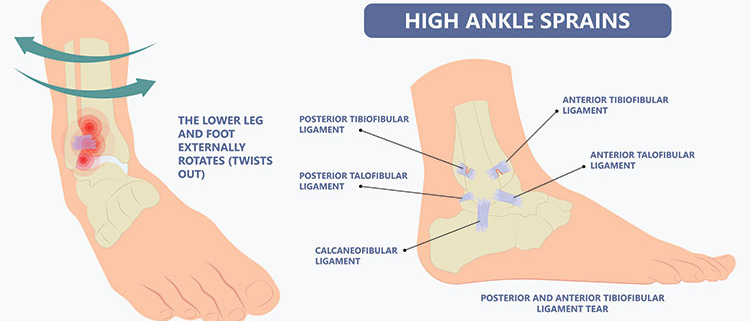High Ankle Sprain – Ankle Syndesmosis

Overview: High Ankle Sprain – Ankle Syndesmosis
High ankle sprain, also known as ankle syndesmosis, is a type of ankle injury that occurs when the connecting tissues between the two bones of the lower leg (the tibia and fibula) are damaged. This typically happens when the foot is forced upwards or outwards, such as during sports or an awkward fall. While high ankle sprains account for only a small portion of all ankle sprains, they tend to take longer to heal and may result in long-term problems if not properly treated.
Types: High Ankle Sprain Variations
While all high ankle sprains involve the same general area, the severity and specific pattern can vary. Ankle sprains are often categorized into three grades:
– Grade I: A mild sprain, where the ligaments are stretched but not torn.
– Grade II: A moderate sprain, where the ligaments are partially torn.
– Grade III: A severe sprain, where the ligaments are completely torn, often requiring surgery.
Causes: High Ankle Sprain
High ankle sprains usually occur from:
– A sudden or intense twisting motion
– Rolling or tripping over the foot
– Direct impact or blow to the ankle during contact sports
– Pushing off the foot forcefully, such as during a sprint or a jump
They are particularly common in activities like football, soccer, skiing, and dance.
Symptoms: Identifying a High Ankle Sprain
Symptoms of a high ankle sprain may include:
– Swelling and bruising around the ankle
– Pain, especially when walking, climbing stairs, or turning the foot
– Instability or feeling of ‘giving way’
- Tenderness on touching the front, outside part of the ankle
In severe cases, you may have difficulty bearing weight on the injured foot.
Diagnosis: How is High Ankle Sprain Diagnosed?
If you exhibit signs of a high ankle sprain, your doctor will perform a physical exam and ask about any recent injuries. They may also request imaging tests, such as:
– X-ray: To look for fractures
– MRI: To get detailed images of soft tissues
– CT scan: To examine bone injuries in more detail
Treatment Options: Dealing with High Ankle Sprain
Treatment for a high ankle sprain varies depending on the severity:
– For Grade I and II sprains, the RICE (Rest, Ice, Compression, Elevation) method is often recommended
– Physical therapy and exercises to regain strength and flexibility in the ankle may also be beneficial.
– Casts or braces could be used to protect the injured tissues during healing.
– In severe Grade III sprains, surgical intervention might be necessary
Living with High Ankle Sprain – Ankle Syndesmosis
While dealing with a high ankle sprain, here are some tips:
– Follow the RICE protocol for symptom management.
– Avoid any activities that may worsen your symptoms.
– Maintain a healthy diet to support your body’s healing process.
– Engage in guided rehabilitation exercises to strengthen your ankle and prevent re-injury.
– Follow all medication instructions provided by your healthcare provider
When to Seek Help
If you’re experiencing severe pain and swelling, cannot bear weight on the ankle, or if the ankle feels “wobbly” or unstable, seek immediate medical attention. Also, if your symptoms have not improved after 2 weeks of self-care avoid delays and seek professional help to reduce the risk of long-term complications. Remember, early and appropriate treatment is key to a successful recovery from high ankle sprain.
